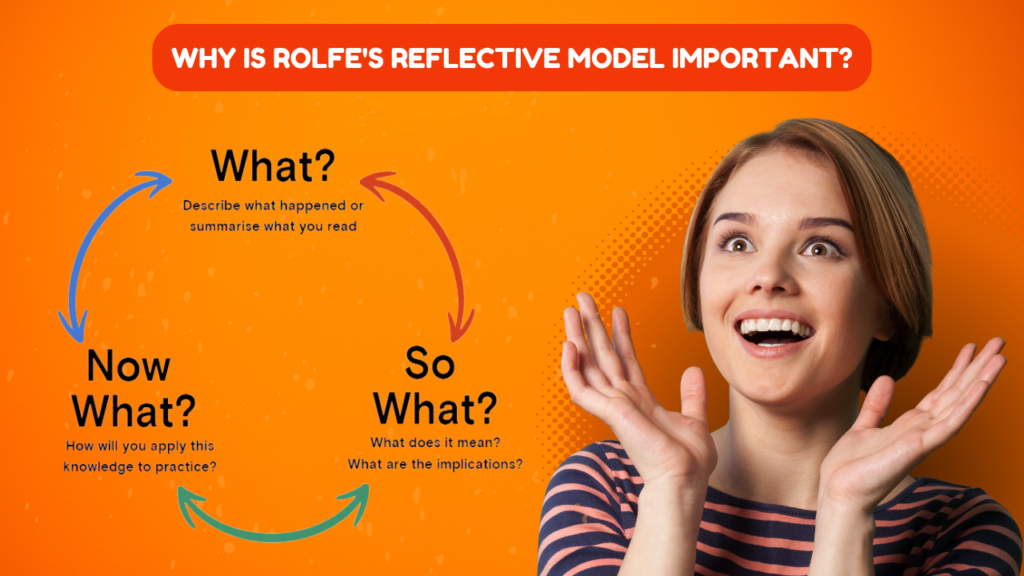Why Is Rolfe's Reflective Model Important?

Overview of Rolfe's Reflective Model:
Rolfe’s Reflective Model is a structured tool used to support reflective practice in professional environments such as healthcare, social work, or education. It was developed by Gary Rolfes and aims at helping an individual to systematically review their actions or experiences, draw lessons and identify areas for personal and professional growth . The model includes three main questions:
What? This is the stage in which the person describes the event or organization’s situation that they want to reflect on . The event, from the account of the individual, the specifics of what took place and the pertinent contextual elements are described.
So What? The interpretation and understanding of the importance of the experience are critical at this level . The individual interprets the umbrella of factors, emotions, and variables concerned, including how the experience influenced the person and how; the thought, action, and practice have all been incorporated.
Now What? The stage wherein the individual clarifies what they have learned from this experience and how the knowledge and thinking may be brought to enhance future practice . This is considered action-orientated reflection, thereby the individual articulates what judgements they’ll take or future approaches they’ll put in place.
Why Is Rolfe's Reflective Model Important?
Organised approach: The organised approach through a process of description, analysis, and action, and a clear and structured structure for the reflective process helps guide people. The structured approach facilitates mental structured, focuses the introspection, and ensures that the insights are applied productively .
Critical thinking: The model encourages individual to review their experiences and appraise their significance and impact and promote the development of critical thinking. It stimulates individuals to make assumptions, investigate their root chases, and consider other perspectives .
Professional Development: Lifelong learning and professional development are both driven by reflective practice. Rolfe’s Reflective Model aids people in identifying potential for growth, areas for development, and strengths in their work . By reflecting on their previous experiences and determining what they have learned as a consequence, people can develop their knowledge, skills, and efficiencies in their professional roles.
Enhanced Self-Awareness: Reflective practice based on Rolfe’s Model attempts to increase self-awareness by encouraging people to reflect on their ideas, emotions, and behaviours connected to their experiences . This increased self-awareness enables individuals to better determine who they are, what goal, and passion drive them, and what their values are.
Rolfe Reflective Model Example
An example of Rolfe’s Reflective Model in action can be illustrated through a scenario where a teacher faces challenges in managing a diverse classroom.
What? The teacher engages in the process of self-description by narrating the situation and identifying the challenges. It includes language barriers and diverse academic levels, along with misbehavior and lack of attention. The teacher describes the context, including the classroom dynamics and the nature of students being taught. ·
So What? The teacher also describes the “so what” part of the reflective model. It involves defining the significance and impact of the described event. The teacher reflects on the way the described challenges affect student
So what? After the reflection, the teacher outlines the steps they can take to improve their practice. The teacher must use more interactive teaching to captivate diverse learning styles, utilize culturally responsive teaching techniques, and create explicit expectations and schedules to support the difficult behavior further. Furthermore, more professional development should be taken to improve skills in managing the difference.
Pros and Cons Rolfe Reflective Model:
Advantages of Rolfe’s Reflective Model:
Structured Framework: It is a structured framework that offers clear guidelines to practitioners on how they should go about reflective practice by taking them through description, analysis, and action in a systematic manner.
Encourages Critical Thinking: The model induces individuals to appraise their experiences critically leading to more profound insights and understanding. It also calls for questioning assumptions, investigating underlying causes and looking at the problem from different angles.
Promotes Professional Development: By using Rolfe’s Model in reflection upon practice this can help professionals ascertain skills they have developed as well as areas they need to improve on, identifying strengths weaknesses and future learning needs in dealing with individual clients.
Disadvantages of Rolfe’s Reflective Model:
Time-Consuming: To engage in reflective practice using Rolfe’s model takes time since one has to take time and write the whole experience about what happen, analyze it and finally reflect on it.
Complexity: This model appears very sophisticated especially to persons who are new to reflective practice or prefer direct approaches towards self-reflection.
Subjectivity: When people use Rolfe’s model for critical reflection, their subjective opinions affect how each person interprets and analyzes his or her own experiences.
How do you reference a Rolfe reflective model?
To reference Rolfe’s Reflective Model in academic or professional writing, you should follow the citation guidelines of the specific style guide you are using (e.g., APA, MLA, Chicago). Generally, you would cite the original source of the model along with the publication year. Here’s how you might reference Rolfe’s Reflective Model in APA style:
In-text citation: According to Rolfe et al. (2001), reflective practice involves a structured process of description, analysis and action.
Reference list entry: Rolfe, G., Freshwater, D., & Jasper, M. (2001). Critical reflection for nursing and the helping professions: A user’s guide. Palgrave Macmillan.
Rolfe Reflective Model Nursing
The Rolfe Reflective Model holds significant relevance in nursing practice as it provides nurses with a framework that guides them in carrying out reflective practice that leads to their career development as professionals. Within nursing profession reflective practice is an essential part of a nurse’s life since it promotes continuous learning and improves patient care thus enhancing clinical outcomes.
Nursing is a difficult profession characterized by intricate moments such as ethical problems and conflicts between health care providers. Nurses who adopt this model can critically think about these experiences systematically thus getting insights about their practices as well as identifying areas where they need to change and improve on.
